TOYOTA PROACE VERSO EV 2022 Repair Manual
Manufacturer: TOYOTA, Model Year: 2022, Model line: PROACE VERSO EV, Model: TOYOTA PROACE VERSO EV 2022Pages: 360, PDF Size: 70.79 MB
Page 61 of 360
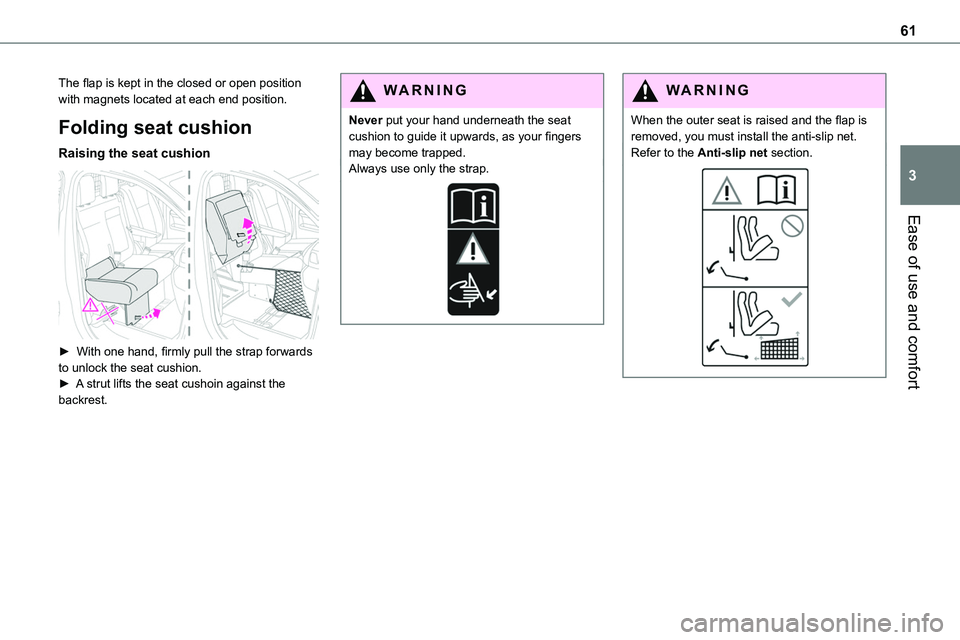
61
Ease of use and comfort
3
The flap is kept in the closed or open position with magnets located at each end position.
Folding seat cushion
Raising the seat cushion
► With one hand, firmly pull the strap forwards to unlock the seat cushion. ► A strut lifts the seat cushoin against the backrest.
WARNI NG
Never put your hand underneath the seat cushion to guide it upwards, as your fingers may become trapped.Always use only the strap.
WARNI NG
When the outer seat is raised and the flap is removed, you must install the anti-slip net.Refer to the Anti-slip net section.
Page 62 of 360
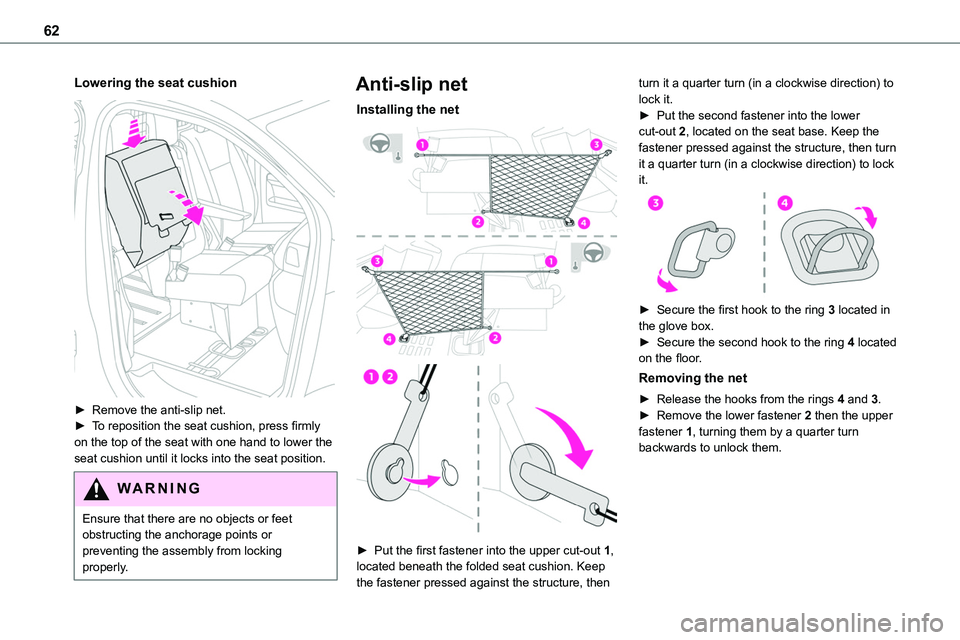
62
Lowering the seat cushion
► Remove the anti-slip net.► To reposition the seat cushion, press firmly on the top of the seat with one hand to lower the seat cushion until it locks into the seat position.
WARNI NG
Ensure that there are no objects or feet obstructing the anchorage points or preventing the assembly from locking properly.
Anti-slip net
Installing the net
► Put the first fastener into the upper cut-out 1, located beneath the folded seat cushion. Keep the fastener pressed against the structure, then
turn it a quarter turn (in a clockwise direction) to lock it.► Put the second fastener into the lower cut-out 2, located on the seat base. Keep the fastener pressed against the structure, then turn it a quarter turn (in a clockwise direction) to lock it.
► Secure the first hook to the ring 3 located in the glove box.► Secure the second hook to the ring 4 located on the floor.
Removing the net
► Release the hooks from the rings 4 and 3.► Remove the lower fastener 2 then the upper
fastener 1, turning them by a quarter turn backwards to unlock them.
Page 63 of 360
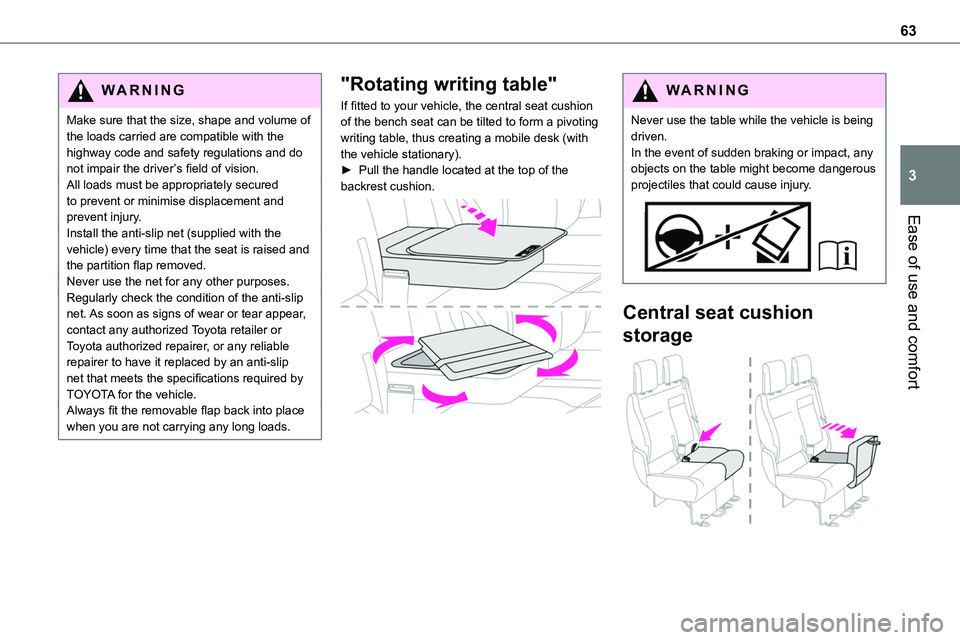
63
Ease of use and comfort
3
WARNI NG
Make sure that the size, shape and volume of the loads carried are compatible with the highway code and safety regulations and do not impair the driver’s field of vision.All loads must be appropriately secured to prevent or minimise displacement and prevent injury.
Install the anti-slip net (supplied with the vehicle) every time that the seat is raised and the partition flap removed.Never use the net for any other purposes.Regularly check the condition of the anti-slip net. As soon as signs of wear or tear appear, contact any authorized Toyota retailer or Toyota authorized repairer, or any reliable repairer to have it replaced by an anti-slip net that meets the specifications required by TOYOTA for the vehicle.Always fit the removable flap back into place when you are not carrying any long loads.
"Rotating writing table"
If fitted to your vehicle, the central seat cushion of the bench seat can be tilted to form a pivoting writing table, thus creating a mobile desk (with the vehicle stationary).► Pull the handle located at the top of the backrest cushion.
WARNI NG
Never use the table while the vehicle is being driven.In the event of sudden braking or impact, any objects on the table might become dangerous projectiles that could cause injury.
Central seat cushion
storage
Page 64 of 360
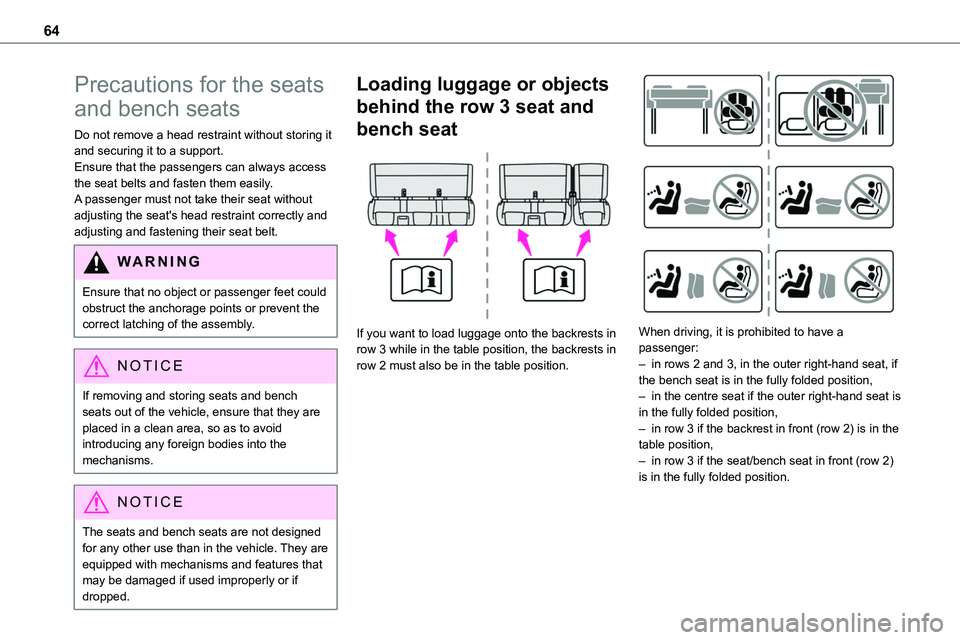
64
Precautions for the seats
and bench seats
Do not remove a head restraint without storing it and securing it to a support.Ensure that the passengers can always access the seat belts and fasten them easily.A passenger must not take their seat without adjusting the seat's head restraint correctly and
adjusting and fastening their seat belt.
WARNI NG
Ensure that no object or passenger feet could obstruct the anchorage points or prevent the correct latching of the assembly.
NOTIC E
If removing and storing seats and bench seats out of the vehicle, ensure that they are placed in a clean area, so as to avoid introducing any foreign bodies into the mechanisms.
NOTIC E
The seats and bench seats are not designed for any other use than in the vehicle. They are equipped with mechanisms and features that may be damaged if used improperly or if dropped.
Loading luggage or objects
behind the row 3 seat and
bench seat
If you want to load luggage onto the backrests in row 3 while in the table position, the backrests in row 2 must also be in the table position.
When driving, it is prohibited to have a passenger:– in rows 2 and 3, in the outer right-hand seat, if the bench seat is in the fully folded position,– in the centre seat if the outer right-hand seat is in the fully folded position,– in row 3 if the backrest in front (row 2) is in the table position,– in row 3 if the seat/bench seat in front (row 2) is in the fully folded position.
Page 65 of 360
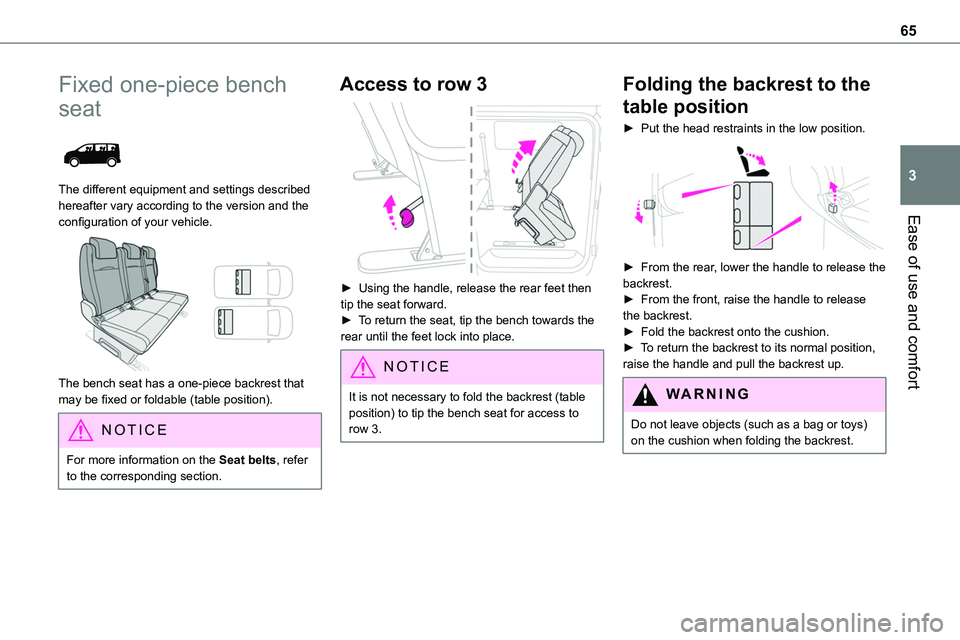
65
Ease of use and comfort
3
Fixed one-piece bench
seat
The different equipment and settings described hereafter vary according to the version and the configuration of your vehicle.
The bench seat has a one-piece backrest that may be fixed or foldable (table position).
NOTIC E
For more information on the Seat belts, refer to the corresponding section.
Access to row 3
► Using the handle, release the rear feet then tip the seat forward.► To return the seat, tip the bench towards the rear until the feet lock into place.
NOTIC E
It is not necessary to fold the backrest (table position) to tip the bench seat for access to row 3.
Folding the backrest to the
table position
► Put the head restraints in the low position.
► From the rear, lower the handle to release the backrest.► From the front, raise the handle to release the backrest.► Fold the backrest onto the cushion.► To return the backrest to its normal position, raise the handle and pull the backrest up.
WARNI NG
Do not leave objects (such as a bag or toys)
on the cushion when folding the backrest.
Page 66 of 360
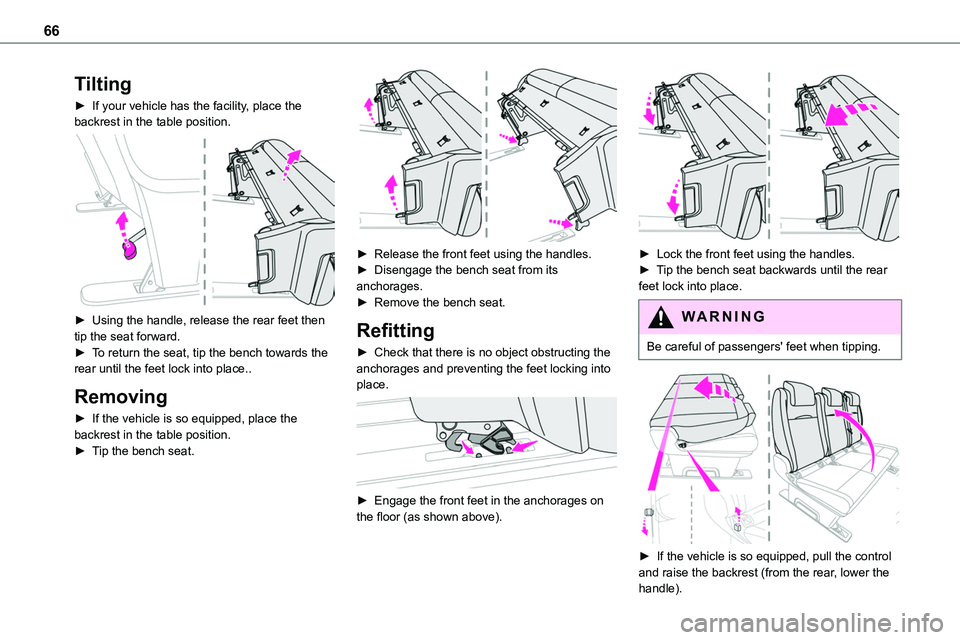
66
Tilting
► If your vehicle has the facility, place the backrest in the table position.
► Using the handle, release the rear feet then tip the seat forward.► To return the seat, tip the bench towards the rear until the feet lock into place..
Removing
► If the vehicle is so equipped, place the backrest in the table position.► Tip the bench seat.
► Release the front feet using the handles.► Disengage the bench seat from its anchorages.► Remove the bench seat.
Refitting
► Check that there is no object obstructing the anchorages and preventing the feet locking into place.
► Engage the front feet in the anchorages on the floor (as shown above).
► Lock the front feet using the handles.► Tip the bench seat backwards until the rear feet lock into place.
WARNI NG
Be careful of passengers' feet when tipping.
► If the vehicle is so equipped, pull the control and raise the backrest (from the rear, lower the handle).
Page 67 of 360
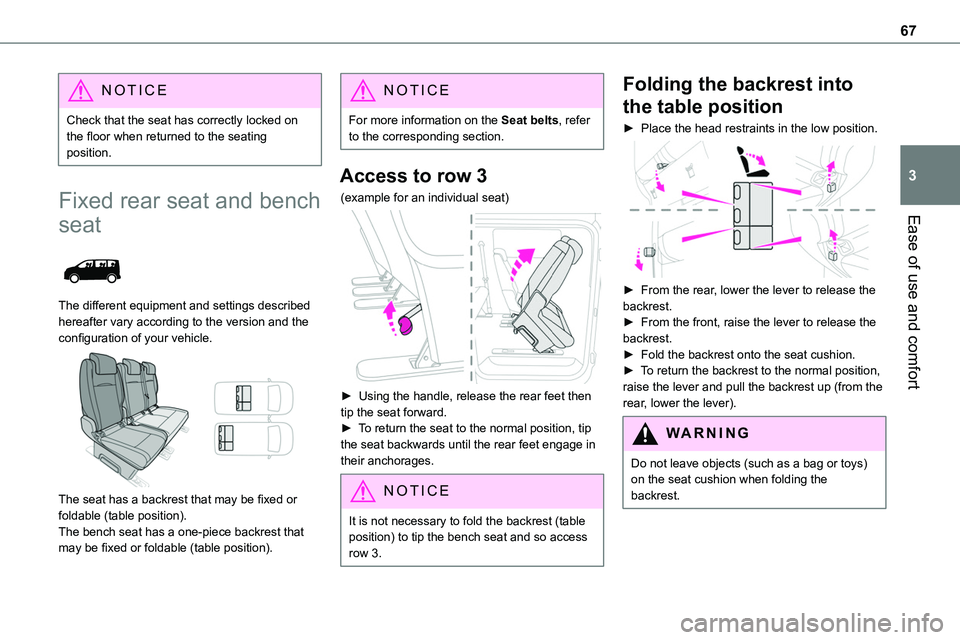
67
Ease of use and comfort
3
NOTIC E
Check that the seat has correctly locked on the floor when returned to the seating position.
Fixed rear seat and bench
seat
The different equipment and settings described hereafter vary according to the version and the configuration of your vehicle.
The seat has a backrest that may be fixed or foldable (table position).The bench seat has a one-piece backrest that may be fixed or foldable (table position).
NOTIC E
For more information on the Seat belts, refer to the corresponding section.
Access to row 3
(example for an individual seat)
► Using the handle, release the rear feet then tip the seat forward.► To return the seat to the normal position, tip the seat backwards until the rear feet engage in their anchorages.
NOTIC E
It is not necessary to fold the backrest (table position) to tip the bench seat and so access row 3.
Folding the backrest into
the table position
► Place the head restraints in the low position.
► From the rear, lower the lever to release the backrest.► From the front, raise the lever to release the backrest.► Fold the backrest onto the seat cushion.► To return the backrest to the normal position, raise the lever and pull the backrest up (from the rear, lower the lever).
WARNI NG
Do not leave objects (such as a bag or toys) on the seat cushion when folding the backrest.
Page 68 of 360
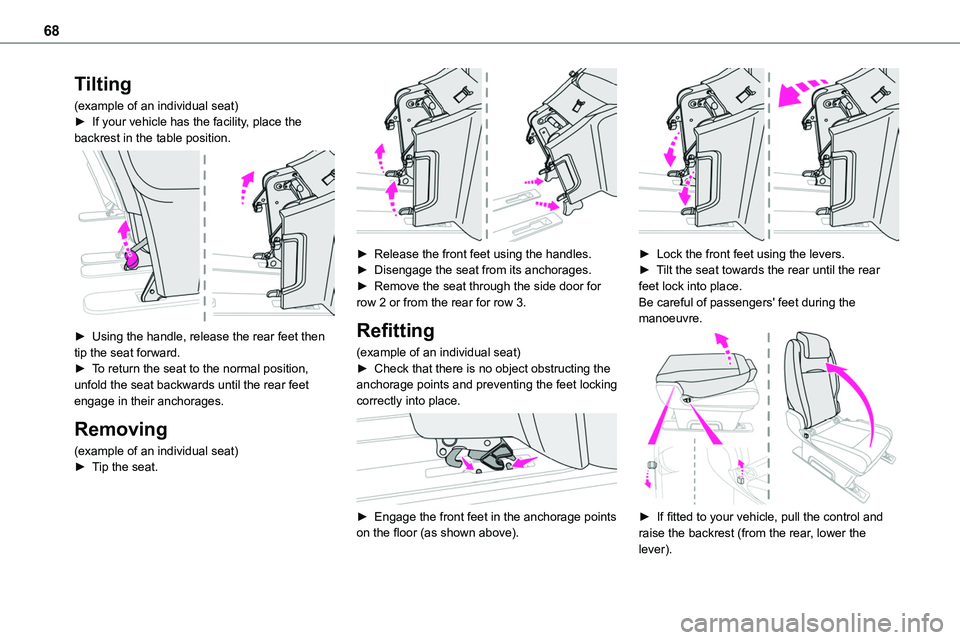
68
Tilting
(example of an individual seat)► If your vehicle has the facility, place the backrest in the table position.
► Using the handle, release the rear feet then tip the seat forward.► To return the seat to the normal position, unfold the seat backwards until the rear feet engage in their anchorages.
Removing
(example of an individual seat)► Tip the seat.
► Release the front feet using the handles.► Disengage the seat from its anchorages.► Remove the seat through the side door for row 2 or from the rear for row 3.
Refitting
(example of an individual seat)► Check that there is no object obstructing the anchorage points and preventing the feet locking correctly into place.
► Engage the front feet in the anchorage points on the floor (as shown above).
► Lock the front feet using the levers.► Tilt the seat towards the rear until the rear feet lock into place.Be careful of passengers' feet during the manoeuvre.
► If fitted to your vehicle, pull the control and raise the backrest (from the rear, lower the lever).
Page 69 of 360
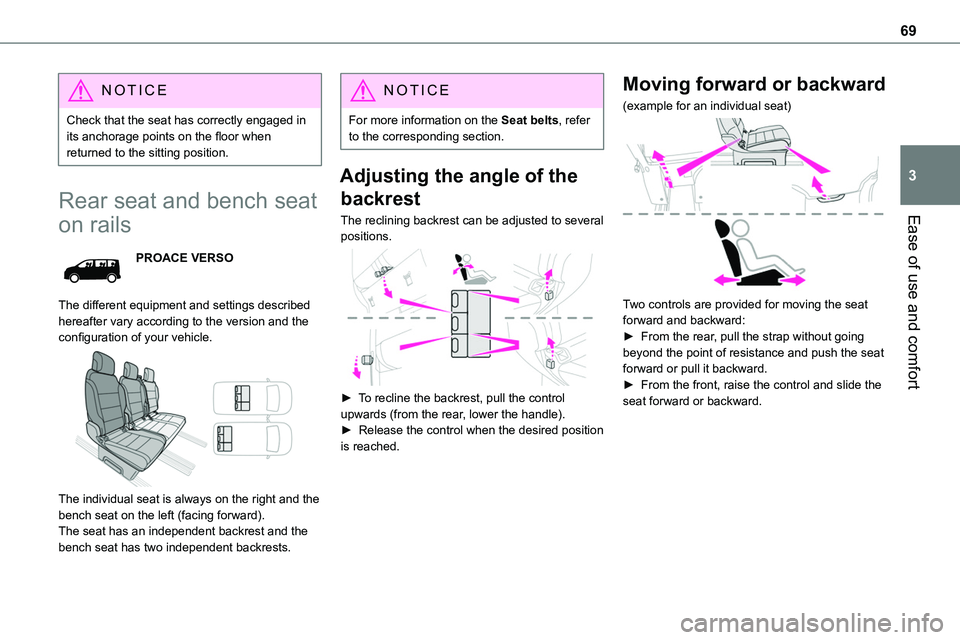
69
Ease of use and comfort
3
NOTIC E
Check that the seat has correctly engaged in its anchorage points on the floor when returned to the sitting position.
Rear seat and bench seat
on rails
PROACE VERSO
The different equipment and settings described hereafter vary according to the version and the configuration of your vehicle.
The individual seat is always on the right and the bench seat on the left (facing forward).The seat has an independent backrest and the bench seat has two independent backrests.
NOTIC E
For more information on the Seat belts, refer to the corresponding section.
Adjusting the angle of the
backrest
The reclining backrest can be adjusted to several
positions.
► To recline the backrest, pull the control upwards (from the rear, lower the handle).► Release the control when the desired position is reached.
Moving forward or backward
(example for an individual seat)
Two controls are provided for moving the seat forward and backward:► From the rear, pull the strap without going beyond the point of resistance and push the seat forward or pull it backward.► From the front, raise the control and slide the seat forward or backward.
Page 70 of 360
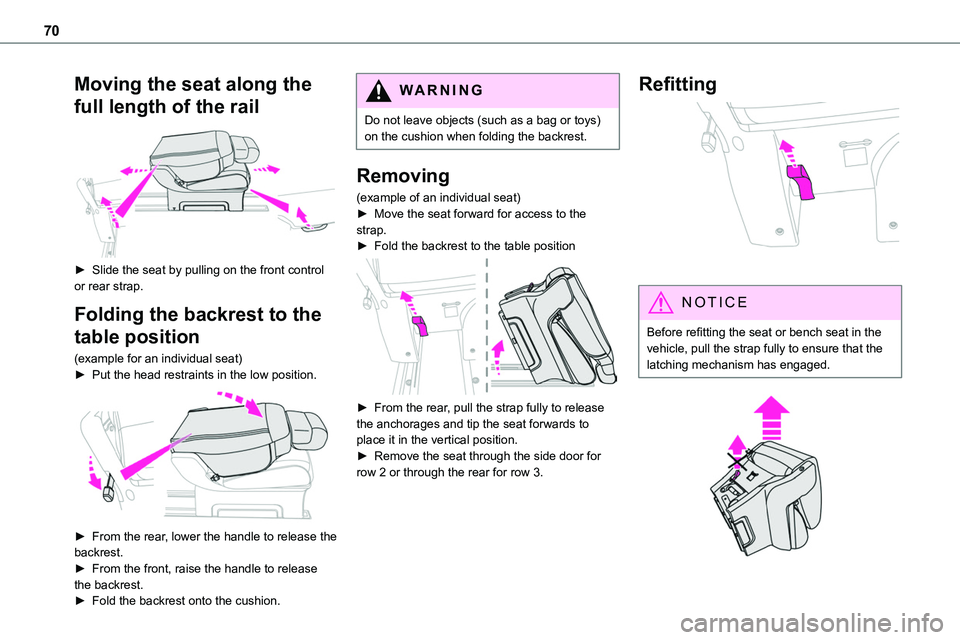
70
Moving the seat along the
full length of the rail
► Slide the seat by pulling on the front control or rear strap.
Folding the backrest to the
table position
(example for an individual seat)► Put the head restraints in the low position.
► From the rear, lower the handle to release the backrest.► From the front, raise the handle to release the backrest.► Fold the backrest onto the cushion.
WARNI NG
Do not leave objects (such as a bag or toys) on the cushion when folding the backrest.
Removing
(example of an individual seat)► Move the seat forward for access to the
strap.► Fold the backrest to the table position
► From the rear, pull the strap fully to release the anchorages and tip the seat forwards to place it in the vertical position.► Remove the seat through the side door for row 2 or through the rear for row 3.
Refitting
NOTIC E
Before refitting the seat or bench seat in the vehicle, pull the strap fully to ensure that the latching mechanism has engaged.